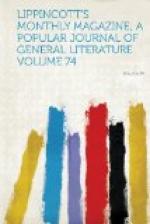Before proceeding to the more special subject of this article—certain interesting and recently-discovered notices of some of the most famous of the old carvers in wood—it may be well to say a word or two on the subject of the commerce in imitations of the mediaeval works so extensively carried on in Italy. Of course, a trade based on deception is in every way to be condemned and regretted. It is not only immoral, but it generates demoralization. But it is to be observed that in very many cases—especially in those branches where art-industry approaches the most nearly to art proper—the artist or artisan who produced the works in question has neither co-operated with the fraud we are speaking of, nor has worked with any view to the perpetration of such by others. In the next place, it is to be noted that the mortification and humiliation which many purchasers are conscious of when it is brought home to them that they have been taken in, and have purchased as old that which is in truth of recent production, may well be spared to them. I do not mean, of course, as regards the money they may have been cheated of, but as regards the slight put upon their own connoisseurship. The art of imitating the old works in question has been brought to such a pitch of perfection that it needs a very special education of the eye and large practice to detect the imposture. A circumstance occurred a few years ago at Florence which curiously illustrates both the facts I have mentioned—the frequent innocence of the producer of the imitation and the extreme difficulty of detecting the modern origin of the work. The facts are very little known, because it was the interest of many persons to misrepresent and conceal them. They ought, nevertheless, to be known, and I do not see any good reason why I should not tell them here.
A young man at Florence of the name of Bastianini—it must be at least ten years ago now, or perhaps more—of very humble origin had shown a remarkable talent for modeling busts in terra-cotta. Having formed his taste for himself, not by means of any academical teaching, but by imbuing his mind with the examples of mediaeval art which meet the eye on all sides in his native city, his works assumed quite naturally the manner and style of the artists who (in more or less direct line) were his ancestors. One day it happened to him to see a man—he was a common workman in the tobacco manufactory—whose head struck him as specially marked by the old Florentine mediaeval type and as a remarkably good subject for a characteristic bust. From this man he made a terra-cotta bust which few could have pronounced to be other than a cinque-cento work, and a very fine one. Bastianini, then quite unknown and much in need of wherewithal to live, sold this bust as the work of his hands to a speculative dealer for, if I remember rightly, five hundred francs. The man who bought it carried it to a dealer in antiquities—a very well-known man in Florence whose name I could




